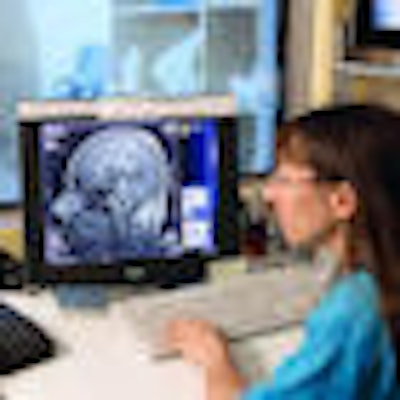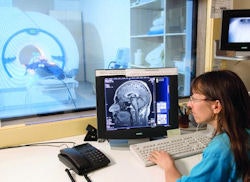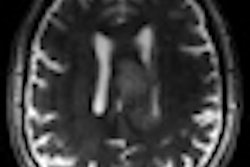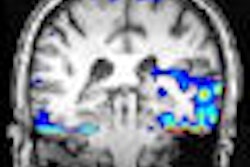

In 2004, the European Commission (EC) adopted a directive restricting occupational exposure to electromagnetic fields. This directive (2004/40/CE), which examines the possible health risks of the electromagnetic fields from mobile phones, Wi-Fi, Bluetooth, and other devices, concluded that upper limits on radiation and applied electromagnetic fields are necessary to prevent workers from suffering any undue acute health effects. But although not initially intended, the biggest impact of the directive could be on MRI, which is used in hospitals worldwide to produce images of unrivalled quality of the brain and other soft tissues.
MRI involves studying how hydrogen nuclei in water molecules respond to an applied static magnetic field. When placed in a sufficiently strong field, the hydrogen nuclei absorb energy from an applied electromagnetic radiofrequency (RF) field and re-emit it in a way that reveals information about the physical and chemical properties of the tissue's environment in the body. MRI is a powerful diagnostic tool that is much safer than techniques that use x-rays or other ionizing radiation.
 |
Stalling progress
The problem with the exposure limits that are outlined in the directive is that they follow the recommendations of the International Commission on Non-Ionizing Radiation Protection (ICNIRP) -- a nongovernmental organization officially recognized by the World Health Organization -- based on a precautionary approach to very limited data, most of which are not relevant to MRI.
Those limits could end up preventing the technique from being used -- just when European scientists are starting to lead the world in ultrahigh-field (UHF) MRI magnet research. The initially proposed limits will immediately put the brakes on progress and, moreover, be a big blow to companies that make MRI scanners and magnets, such as Siemens, Philips, Bruker, and Magnex. These firms could end up being unable to meet the growing global demand for clinical UHF MRI scanners, the high fields from which could boost the potential of MRI for healthcare and biomedical sciences, particularly for neurological applications.
Investigations conducted by the EC and the U.K. government concluded that MRI workers routinely exceed the exposure limits in the directive -- despite no evidence that they experience any ill effects as a result. This fact led the EC to postpone until April 2012 the implementation in member states of the directive, which had been due to come into effect on April 30, 2008 -- the idea being to allow a satisfactory solution to be found.
However, in April of this year, the ICNIRP published yet another report -- this time setting guidelines for static magnetic fields. (The initial guidelines set by the ICNIRP addressed only time-varying electromagnetic fields of up to 300 GHz.) If included in the directive, the new guidelines would have an even greater impact on the development of MRI technology in Europe.
While I applaud the ICNIRP for putting together an outstanding review of the literature on the known or reported effects of magnetic fields in biological tissues or organisms, it should be pointed out that regulations based on current (and necessarily limited) literature might potentially prevent any progress in MRI. The problem is that the proposed guidelines state that only a worker's limbs can be exposed to fields between 2 and 8 tesla. But because the magnets that produce such fields are so much bigger than the distance between the limbs, the trunk, and the head, it is difficult -- if not impossible -- to expose a patient's limbs to such a field without exposing their trunk and head too. The upshot is that it will no longer be possible to build, test, validate, maintain, and use biomedical magnets greater than 2 tesla in Europe.
Although the report says that exposing the head and the trunk to 2- to 8-tesla fields might be "justified for some specific work applications when the environment is controlled and appropriate work practices are implemented," this possibility remains to be clarified within the directive. Exposure to magnetic flux densities greater than 8 tesla is not even considered, as the report says that "not enough information is available on which to base exposure limits beyond 8 tesla."
There is, however, a growing worldwide demand for clinical MRI scanners operating above 3 tesla. These high fields can be used to image the brain, anatomically and functionally, with unsurpassed spatial and temporal resolution to detect, for example, the onset of Alzheimer's disease. MRI with ultrahigh fields also makes it possible to image molecules other than water, such as important ions, metabolites, and neurotransmitters, or tracers specially designed to reveal molecular or cellular disorders.
Indeed, there are currently well over 1,000 3-tesla MRI scanners and more than 30 7-tesla clinical MRI systems in use -- or about to be installed -- around the world, more than half of which are in Europe. Two 9.4-tesla human MRI scanners are already operating in Germany, while France will soon install an 11.7-tesla clinical MRI system. UHF systems for biomedical research on animals are even more common, some of which have fields of greater than 16 tesla. Yet there have been no published reports of these scanners having any adverse affect on workers at those sites.
It seems that the new ICNIRP report focuses on 2 tesla and 8 tesla because reliable literature is available only up to these field strengths, and not at higher strengths. However, these upper values must not be mistakenly understood by lawmakers as real critical thresholds, but rather technical limits at a given time, thus leaving room for progress. Furthermore, the report acknowledges that "guidance is not based on time-averaged exposure because, in addition to the experience gained with the use of MRI and other static field sources worldwide over the last 20 years, mechanistic considerations indicate that any effects are likely to be acute."
Political challenges
Although patients undergoing MRI scans are not affected by the directive, they are nonetheless also exposed to the same field strengths (or even slightly higher as they are at the center of the magnets). The ICNIRP report points out that the exposure limits for the general public should be derived by applying a reduction of five with respect to the occupational limit, which corresponds to 0.4 tesla. Guidelines for patients are still in preparation.
The situation is much better in the U.S., where the Food and Drug Administration (FDA), which considers MRI to be a "minimal risk" procedure up to 8 tesla, has continuously extended its recommended limits for subject exposure over the past few years from 2 tesla to 4 tesla, and now to 8 tesla for anyone age 1 month or older. UHF MRI can still be used on human subjects beyond this limit -- in fact, there are two 9.4-tesla MRI clinical scanners in the U.S., with an 11.7-tesla system about to be installed, albeit under the approval of a local institutional review board.
Indeed, there are no reports in the literature showing that ultrahigh fields have any real impact on health. Of course, electromagnetic fields could have fundamental biological effects, but the question is whether those effects can actually harm a person or their organs. So although the EC's directive should, in principle, be welcomed, as it seeks to promote environmental protection and workers' health and safety, the problem is that it encompasses very broad aspects of the health concerns associated with electromagnetic fields and was not intended for MRI. As a recent European Parliament resolution points out, "the use of MRI must not be threatened by directive 2004/40/EC as MRI technology is at the cutting edge of research, diagnosis, and treatment of life-threatening diseases for patients in Europe."
UHF MRI is progressing rapidly, especially in Europe -- there are already sites with MRI magnets operating above 8 tesla, with more to come. The fact that no reports of adverse effects have been published, so far, is reassuring, but caution must, of course, be exercised when exposing people, patients, or workers to ultrahigh fields.
The challenge for politicians and the EC over the next two years is to create regulations that are flexible enough to not only protect workers, but also allow research in the field to progress. They need to work with patient groups, healthcare professionals, trade unions, industrial MRI manufacturers, and biomedical research institutions.
The European Union and its member states must carry out and fund, without delay, biological and epidemiological studies on the effects of ultrahigh fields on tissues and organisms. Meanwhile, in the absence of available data, we should permit tests that expose people to static fields greater than 8 tesla -- provided that appropriate precautionary measures are taken -- and ensure that these limits can be extended if current or future studies suggest it is safe to do so.
By Denis Le Bihan
Physicsworld contributing editor
October 9, 2009
Denis Le Bihan is director of the NeuroSpin intense-field neuroimaging project at the CEA-Saclay Center, Gif-sur-Yvette, France.
Related Reading
7-tesla breast MRI shows advantages in first tests, March 13, 2009
© IOP Publishing Limited. Republished with permission from physicsworld.com.




















